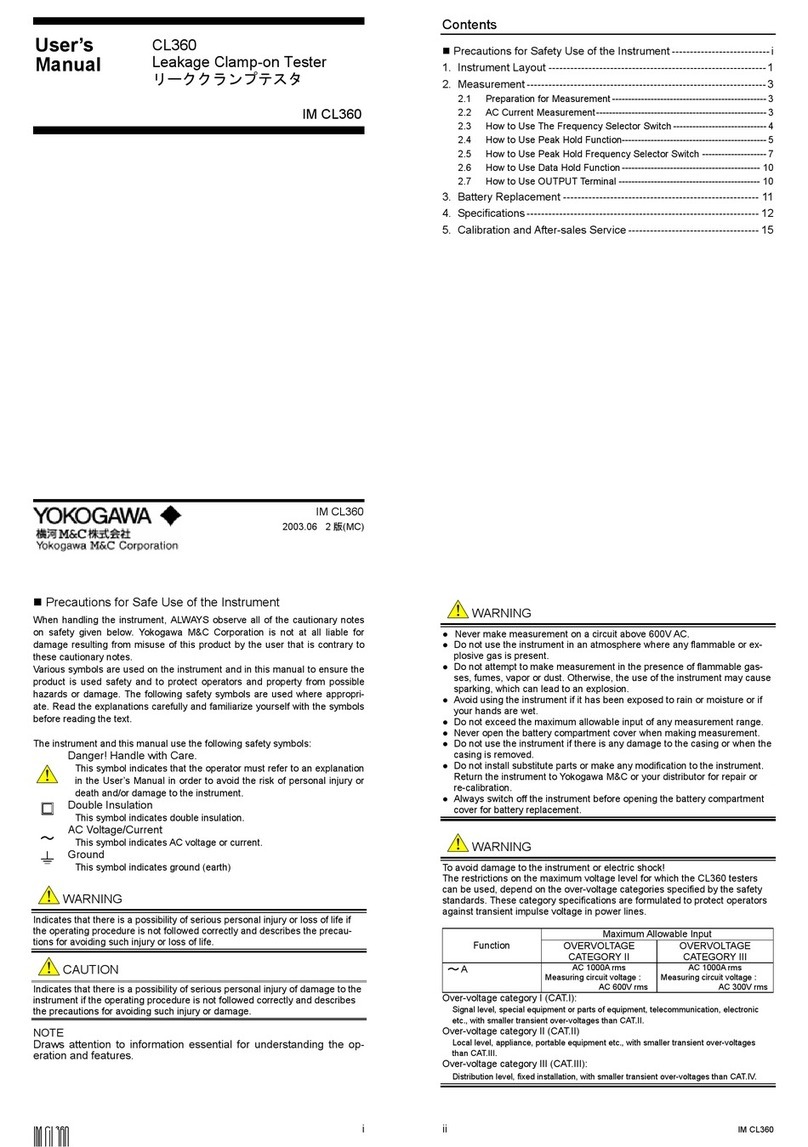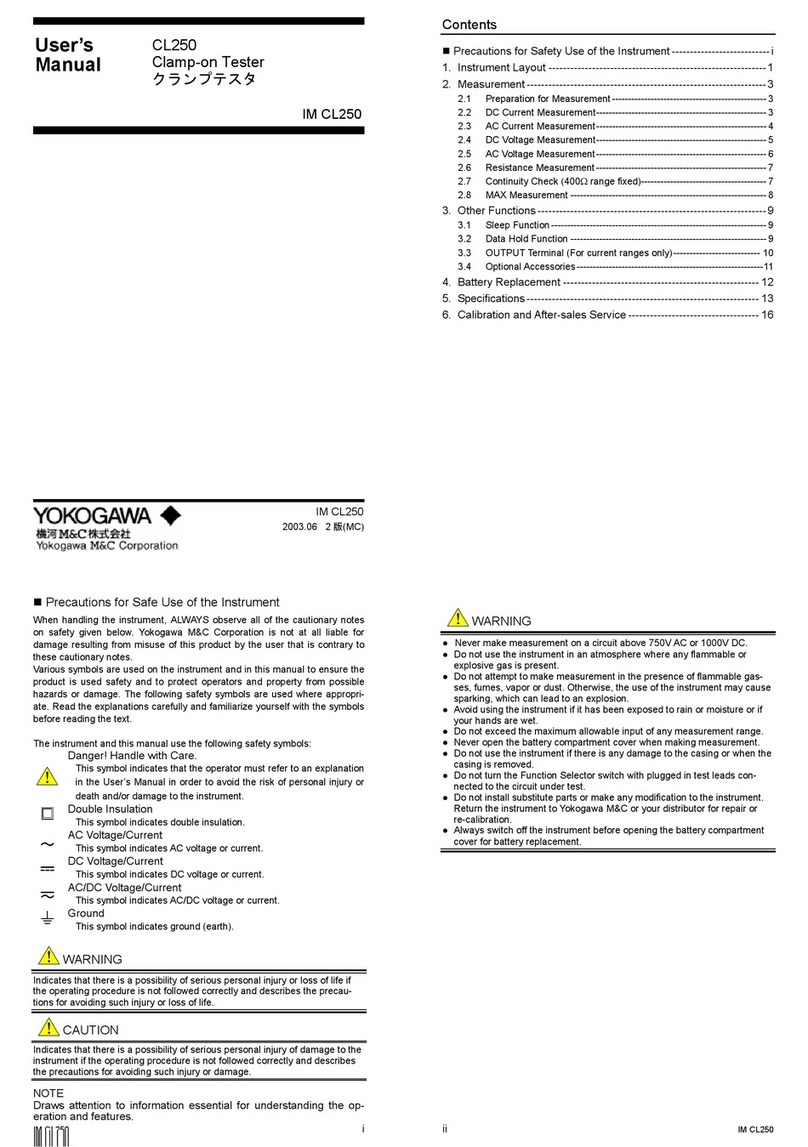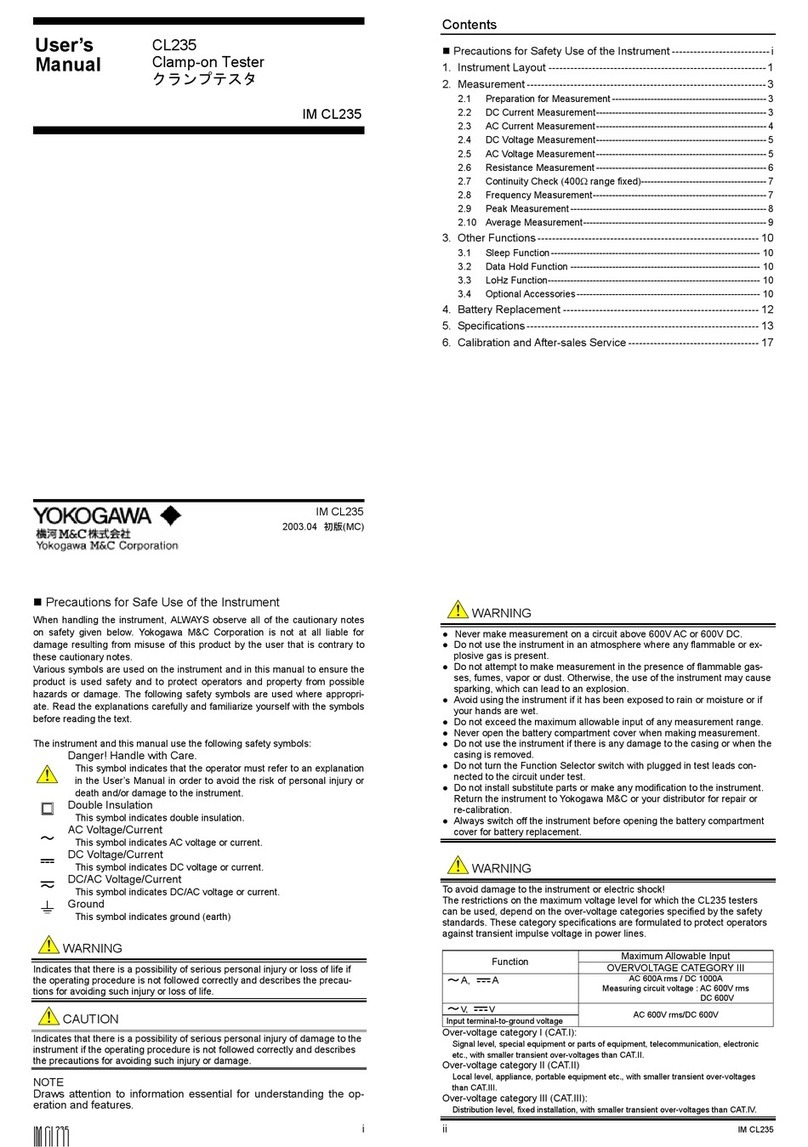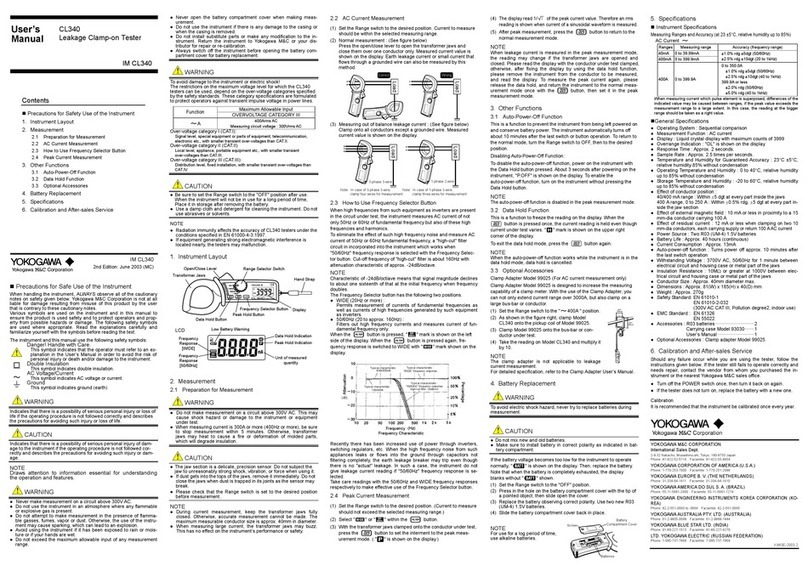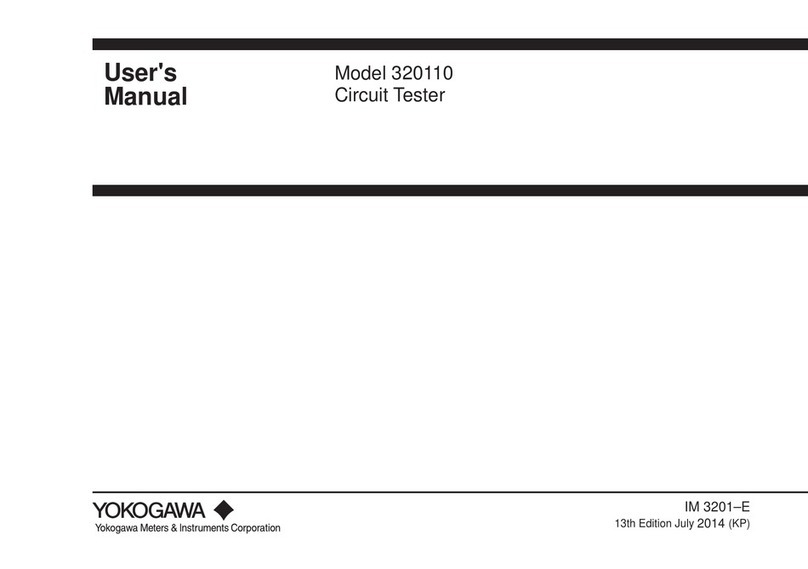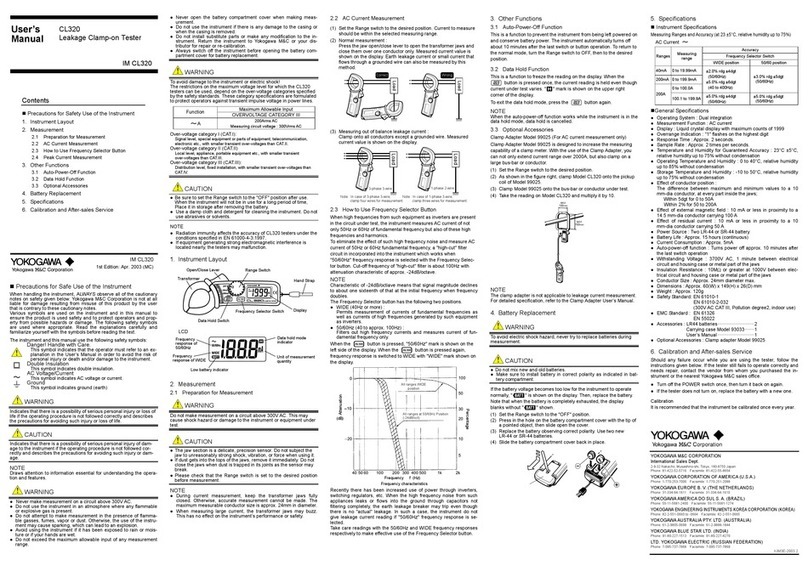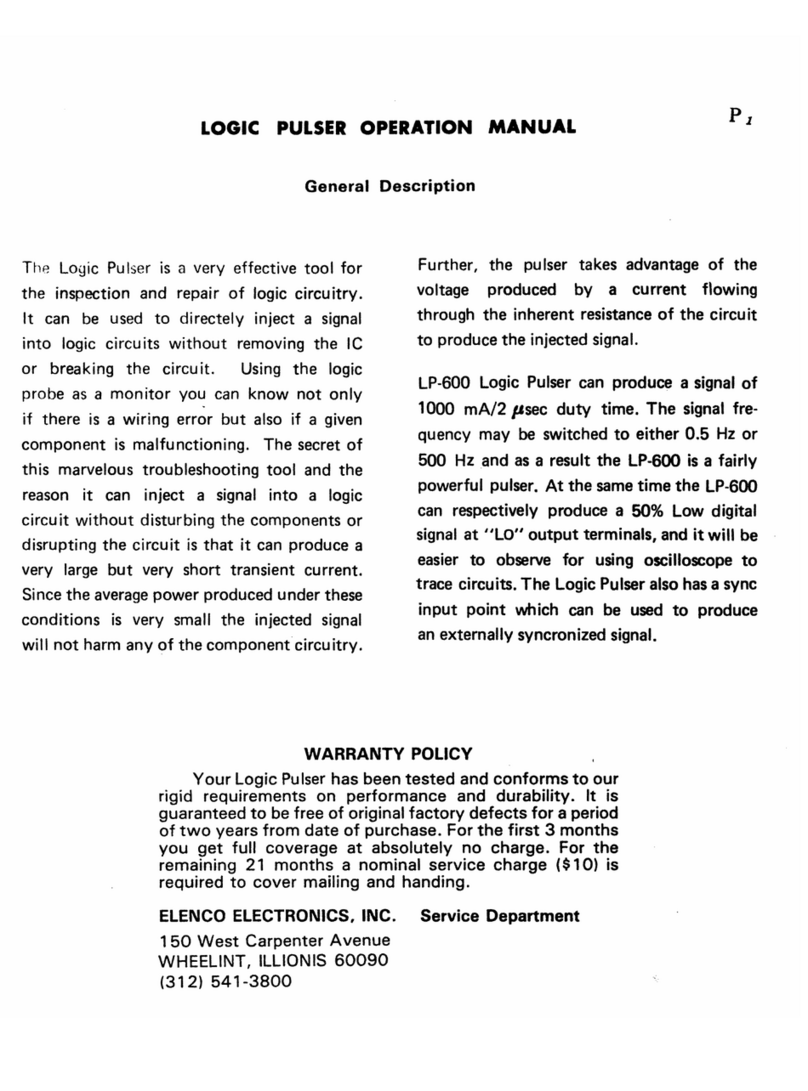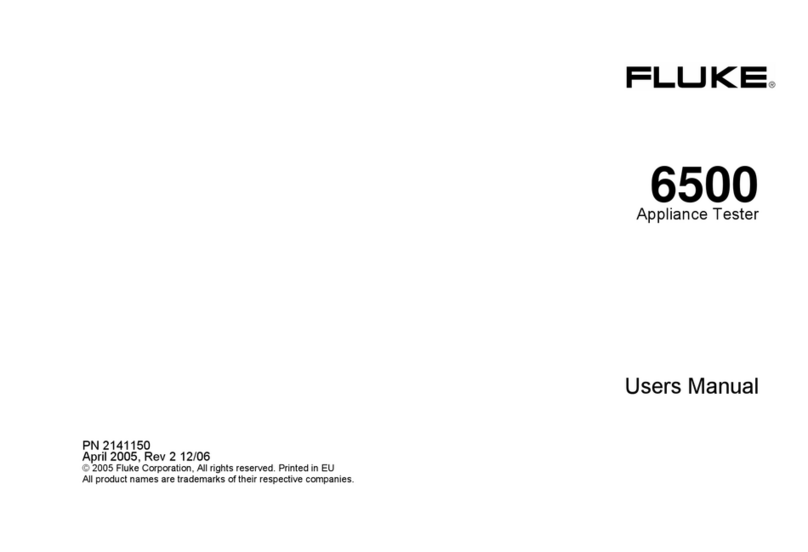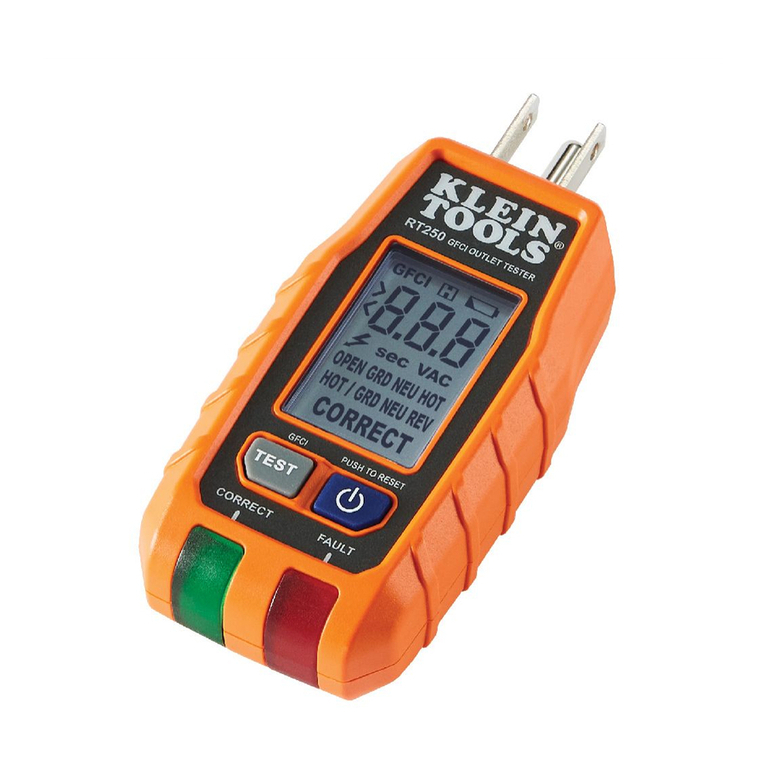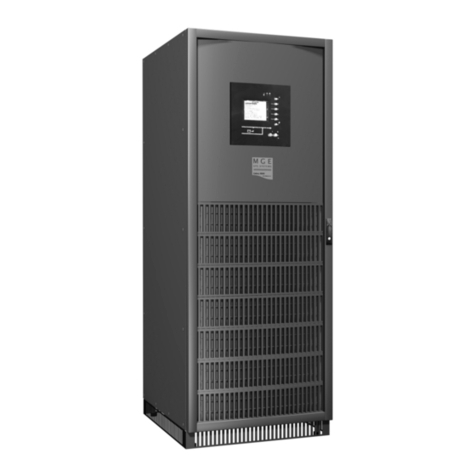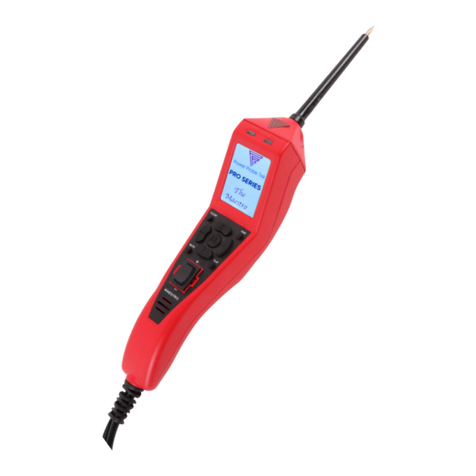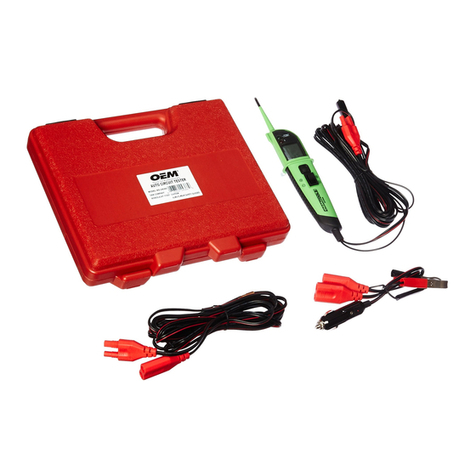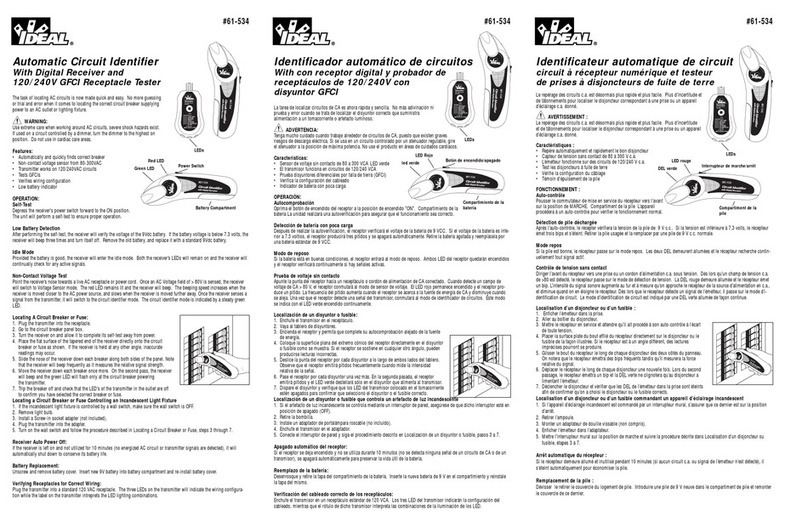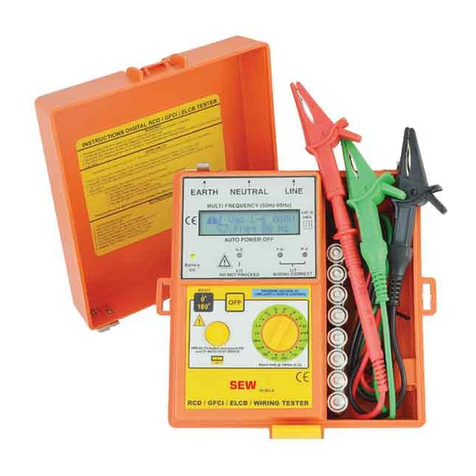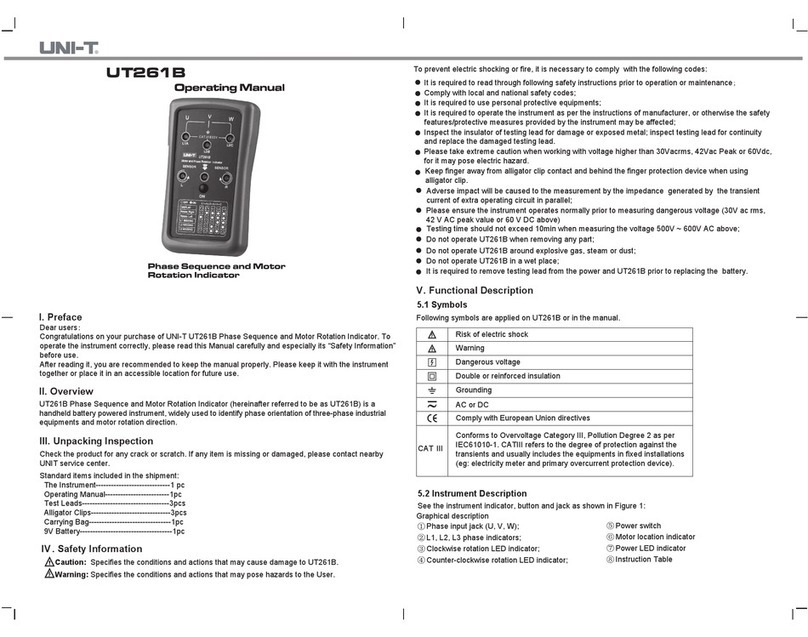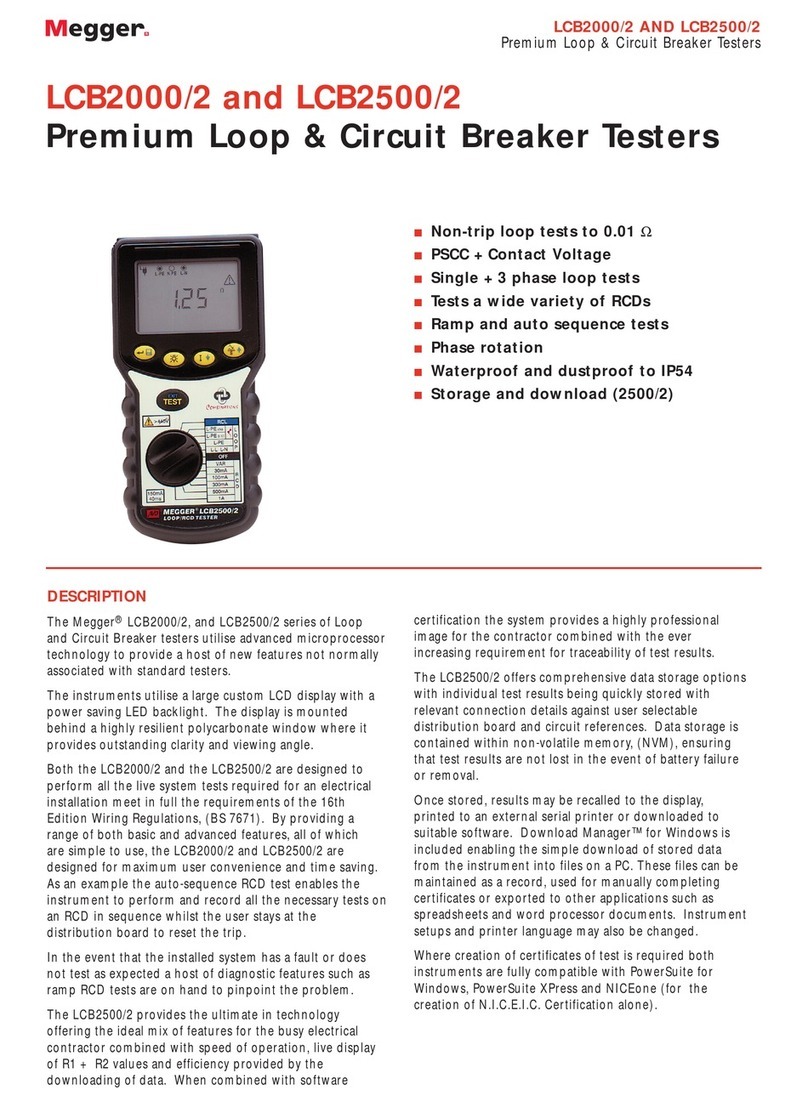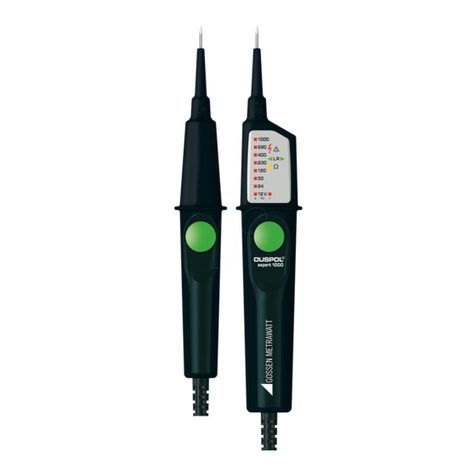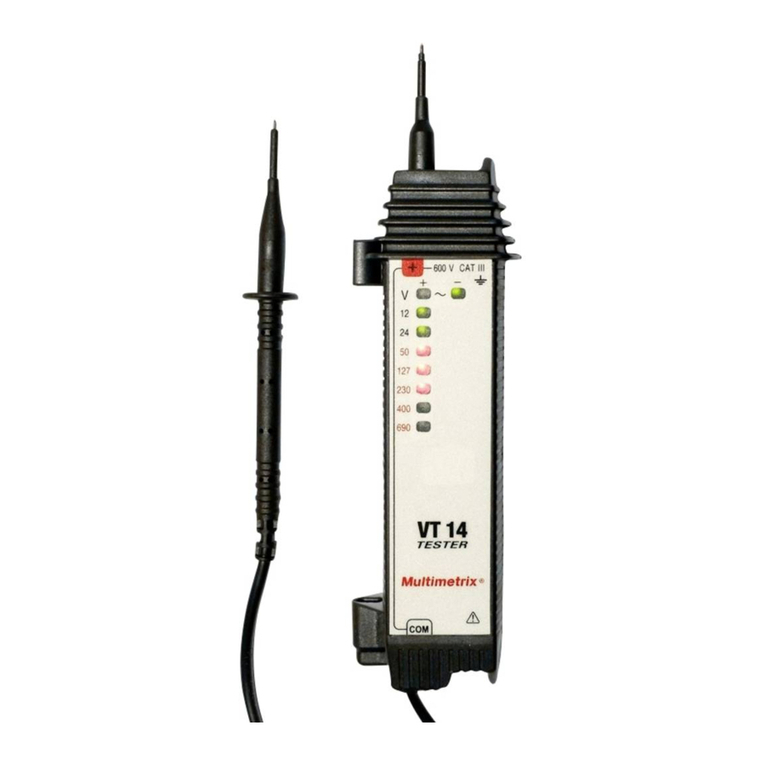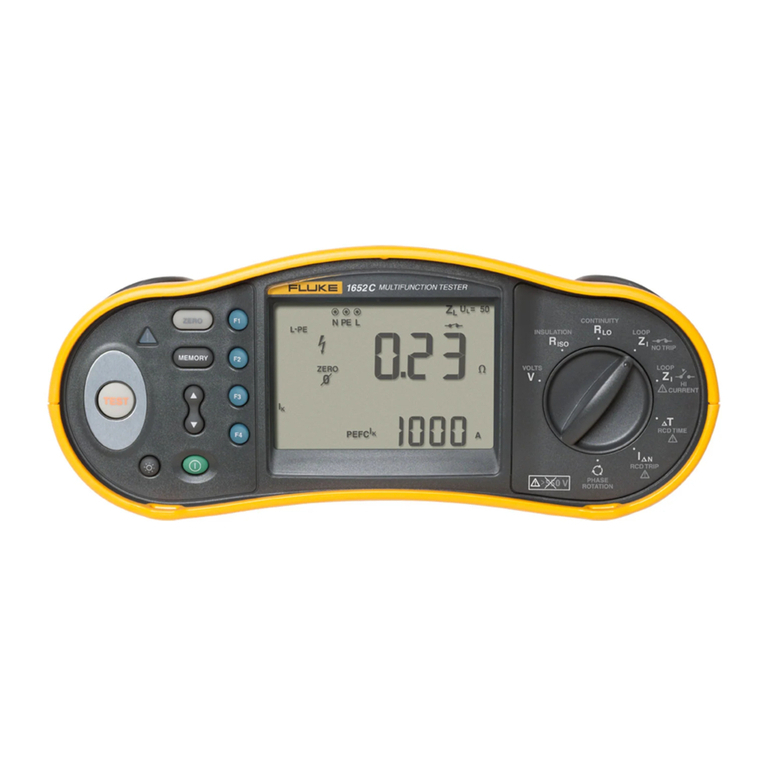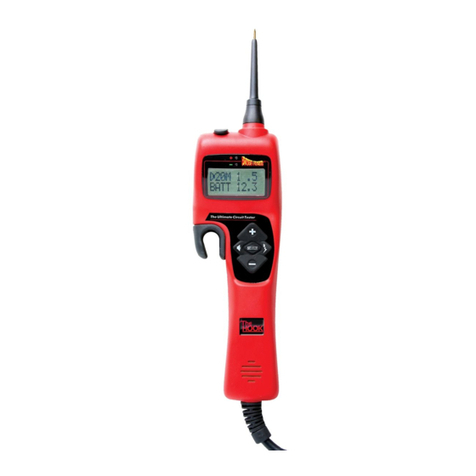
IM MY10-E
1st Edition: Jan. 2000
User’s
Manual Model MY10
Insulation ResistanceTester
Store this manual in a safe place for future reference.
Thank you for purchasing theYokogawa M&C MY10 Insulation Tester.
To optimize all the functions of the instrument, please read this manual
thoroughly before operating it.
1. Safety Precautions
Always observe the following instructions. Failure to do so may result
in electric shock or other dangers that may lead to serious injury or the
loss of life.
Yokogawa M&C Corporation is in no way liable for any damage result-
ing from the user's mishandling of the tester.
For safe use of this tester, the following safety symbols are used in the
user's manual:
WARNING
Thisindicatesthatthe operator mustrefer to an explanation in the user’s
manual in order to avoid the risk of serious injury or the loss of life.
CAUTION
This indicates that the operator must refer to an explanation in the
user’s manual in order to avoid the risk of injury or damage to the
tester.
Note
This provides important information for handling the tester and clari-
fies tester functions.
The following symbols are used on the MY10 tester.
Danger! Handle with Care.
This symbol indicates that the operator must refer to an explanation in
the user’s manual in order to avoid risk of injury or death of personnel
or damage to the tester.
High-voltage Terminal
This symbol indicates a dangerous voltage level (terminals with volt-
ages exceeding 1000 volts must be so marked).Never touch the termi-
nals. AC Voltage
This symbol indicates the presence of an AC voltage.
Double Insulation
This symbol indicates double insulation.
WARNING
■ Always observe the following instructions. Failure to do so may
result in electric shock or other dangers that may lead to serious
injury or the loss of life.
1. During Measurement of Insulation Resistance
• A high voltage is present at the probes. Do not touch the measured
object or the earth or line terminal.
2. Immediately After Measurement of Insulation Resistance
• The probes or the measured object may remain highly charged.
Do not touch them immediately after the completion of measurement.
3. During Measurement of AC Voltages
• Do not press the MEAS key while measuring AC voltages.
• Voltage that exceeds the specified limit must not be applied to terminals.
4. Probes
• Use the probes supplied by Yokogawa M&C with this tester.
• Do not use probes that have deteriorated or are defective.
• Remove the probes from the measured object before attaching/
detaching the probes to/from the tester.
5. Insulation of Casing
• A puncture in the protective insulation may occur if there are any
cracks or other damage in the casing as a result of the instrument
having been dropped or knocked against another object.
Do not use the instrument before taking the necessary remedial
measures; ask the manufacturer to repair it.
6. The Measured Object
• Turn off the power to the measured object before you begin
measuring insulation resistance.
• Avoid touching any electrified parts while using the tester in
a location with live electricity. For safety, it is recommended that
you use a pair of rubber gloves or other alternative means.
7. Operating Environment
• Do not operate the tester in an atmosphere where any flammable
or explosive gas is present.
• Do not use the tester if there is condensation on it.
8. Disassembly
• No person, except personnel from Yokogawa M&C, is authorized
to disassemble this tester.
2. Measuring Functions and Additional Features
■ Measuring Functions
• Measuring the insulation resistance
• Measuring AC voltages (sine wave at 50/60 Hz)
■ Additional Features
•Discharge feature
The tester is designed to begin discharging when the MEAS
key is turned off.The ALARM LED turns off when discharging
is complete.
•Battery check
Thisfunction verifies ifthe battery voltages arewithin the valid
ranges. (When the battely is checked, the pointer must be
within the BATT mark.)
•Phosphorescent scale plate
The indicator window lights up according to the intensity of
light.
•Locking the MEAS key
Pulling the MEAS key up allows for continuous measurement
over a prolonged period of time.
3. Components and Their Functions
1. Indicator window
3. BATT CHECK key
2. MEAS key 6. ALARM LED
Front view Rear view
Side view
5. Zero adjustment (screw)
7. Battery cover setscrew
8. Battery cover
9. Shoulder strap guide
10. Earth terminal
11. Line terminal
4. Protective cover fitting
1. Indicator window
2. MEAS key
3. BATT CHECK key
Verifies if the battery voltages are within the valid ranges.
4. Protective cover fitting
5. Zero adjustment (screw)
6. ALARM LED
• Discharge feature (On➞Off)
When lit, it indicates that a capacitive component in the
measured object remains electrified and will light up even if
measurementhasbeen completed.It turns offwhendischarge
is complete.
7. Battery cover setscrew Undo to replace batteries.
8. Battery cover
9. Shoulder strap guide The shoulder strap is passed through it.
10. Earth terminal Connection for earth probe.
11. Line terminal Connection for line probe.
Note
• GUARD function is not a standard function.
4. Before Measurement
1. Safety
•Read the handling precautions in this manual carefully.
•Make sure it is safe before starting measurement.
2. How to Read the Scale
•Read the value from the top-right of the scale.
3. Zero Adjustment
•Confirm that the pointer is at the center of the infinity sign (∞);
if it is, do not press the MEAS key.
•Ifit isnot, adjust thepointer toindicate thecenter of theinfinity
sign(∞)withthezeroadjustmentscrewusingaslottedscrewdriver.
4. Battery Voltage Verification
•Pressthe BATTCHECK keyto makesure thebatteryvoltages
are within the valid ranges.(When the battely is checked, the
pointer must be within the BATT mark.)
•Ifthebatteriesare low,replacethem asspecifiedin the battery
replacement section of this manual.
5. Connecting the Probes
•Plug the earth probe into the earth terminal.
•Plug the line probe into the line terminal.
WARNING
• Remove the probes from the measured object before attaching/
detaching the probes to/from the tester.
• Make sure the MEAS key is off when attaching/detaching
the probes to/from the tester.
5. Measuring the Insulation Resistance
1. Before Connecting the Probes
WARNING
• Turn off the power to the measured object before connecting the
probes or measuring insulation resistance.
• Electrical charges may be present in the cables attached to
or metal of the electrical equipment being tested. Verify that
the equipment is free from electrical charges before connecting
the testing terminals.
2. Connecting the Earth Probe
•Securely connect the earth probe to the measured object’s
ground line (if the measured object is not grounded, this
process may be omitted).
3. Connecting the Line Probe
•Bring the line probe into contact with the measured object,
and then press the MEAS key.The pointer indicates the insu-
lation resistance of the measured object.
Note
During measurement, exercise care to prevent the leadwire of
the line probe from coming into contact with the ground, floor or
any other object. Not observing this precaution may result in
a failure to measure the correct insulation resistance.
4. After Measurement
WARNING
• Immediately after measurement, electrical charges resulting from
the applied testing voltage may remain present in the probes or
measured object.
• The tester, therefore, is designed to automatically begin
discharging electricity upon completion of measurement.Verify
that the ALARM LED turns off when discharging is complete.
Locking the MEAS Key (for Continuous Measurement)
The MEAS key, when pulled up to the right, can be locked to ensure
the key remains turned on. Use this mechanism when making continu-
ous measurement over a prolonged period. Note, however, that leav-
ing the key turned on for an unreasonably long time will accelerate the
discharge of the batteries.
Battery Life (reference only)
For MY10-03 at rated 500 V/100 MΩ:
Approximately 10 hours when in continuously operation with central
indication (approx. 2 MΩ; with standard supplied batteries).
Note
The data above is typical. Nevertheless, the battery life varies
depending on the operating conditions. Check the batteries before
measurement.
6. Measuring AC Voltages
WARNING
•
Do not press the MEAS key while measuring AC voltages.
Otherwise, it may result in a failure.
• Voltage that exceeds the specified limit must not be applied to
terminals.
1. Connecting the Earth Probe
•Securely connect the earth probe to the measured object’s
ground line (if the measured object is not grounded, this
process may be omitted).
2. Connecting the Line Probe
•Bringthe lineprobe intocontact with
the measured object.
Thepointerindicatesthe ACvoltage.
Read the value on the voltage
measurement scale (~ V).
If the voltage of 20 V AC or more is
present between the earth and line
terminals,the ALARMLEDturnson.
Note
When measuring insulation resistance, the tester can also be used
to verify that there is no voltage present at the measured object.
1st Edition : Jan. 2000(YG)
All Rights Reserved, Copyright©1999,Yokogawa M&C Corporation
■AboutThis Manual
The contents of this manual are subject to change without prior notice.
Under absolutely no circumstances may the contents of this manual
be transcribed or copied, in part or in whole, without obtaining permis-
sion.
Every effort has been made to ensure accuracy in the preparation of
this manual. Should any errors or omissions come to your attention
however, please inform Yokogawa M&C Corporation accordingly.
3rd Edition: July. 2001
